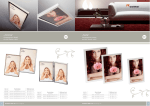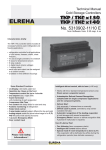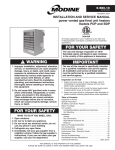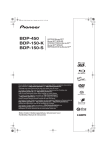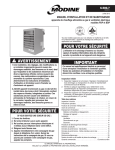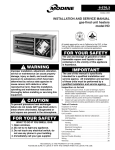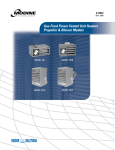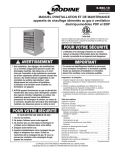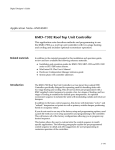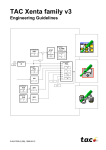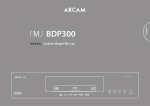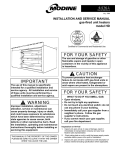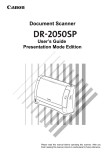Download WARNING - Modine
Transcript
10-204.9 May, 2004 APPLICATION DATA greenhouse blower unit heaters models BD, BDP and BSH Contents Application . . . . . . . . . . . . . . . . . . . . . . . . . . . . . . . . . . . . .2 Blower Unit Heater Benefits . . . . . . . . . . . . . . . . . . . . . . . .2 Unit Control . . . . . . . . . . . . . . . . . . . . . . . . . . . . . . . . . . . .3 Locating Units . . . . . . . . . . . . . . . . . . . . . . . . . . . . . . . . . . .3 Location Precautions . . . . . . . . . . . . . . . . . . . . . . . . . . . . .3 Selection Procedure . . . . . . . . . . . . . . . . . . . . . . . . . . . . . .4 Unit Layout . . . . . . . . . . . . . . . . . . . . . . . . . . . . . . . . . . . . .9 Polytube Installation . . . . . . . . . . . . . . . . . . . . . . . . . . . . .10 Low Return Air Duct . . . . . . . . . . . . . . . . . . . . . . . . . . . . .10 Dimensions . . . . . . . . . . . . . . . . . . . . . . . . . . . . . . . . .16, 17 Control Systems . . . . . . . . . . . . . . . . . . . . . . . . . . . . .18, 19 Unit Installation & Adjustment . . . . . . . . . . . . . . . . . . . . . .18 Performance Data . . . . . . . . . . . . . . . . . . . . . . . . . . . .12-15 Ordering . . . . . . . . . . . . . . . . . . . . . . . . . . . . . . . . . . . . . .19 WARNING To prevent premature heat exchanger failure do not locate ANY gas-fired units in areas where chlorinated, halogenated, or acid vapors are present in the atmosphere. Figure 1.1 Typical polytube heated air distribution under thermal blanket in greenhouse, reduces heating space, cuts heat loss area, saves fuel. THERMAL BLANKET HEATING AND RECIRCULATING UNIT HEATING AND RECIRCULATING UNIT POLY-TUBE (by others) Figure 1.2 Typical heating application with continuous air circulation. HEATING AND RECIRCULATING UNIT HEATING AND RECIRCULATING UNIT POLY-TUBE (BY OTHERS) APPLICATION Applications with Thermal Blankets Figure 2.1 Centrifugal blower fan with electric motor and adjustable belt drive. Motor and controls are exposed for easy servicing. Since most of the heat used in a greenhouse is required at night, many growers are adding thermal blankets to reduce heating space and heat loss through the roof of the greenhouse. In addition there is a strong trend to use under-the-bench heating systems for greater efficiency and fuel savings. For these applications Modine offers gas-fired blower-type unit heaters with a discharge transition for use with polytube for heated-air distribution below the thermal blanket even down to the ground level. Blower-type units permit effective air distribution against static resistances up to 0.4 inches W.C. (0.5" W.C. High Efficiency II), so they can be suspended above the thermal blanket, and connected to a polytube via two 90-degree elbows or thick walled flexible plastic tubing. Operation then can be controlled with a simple low-cost thermostat located below the thermal blanket and at plant level. Wide Size Range Widens Use Blower-type unit heaters are available in 6 separated combustion sizes ranging from 130,000 to 340,000 BTU/HR input, 12 standard and High-Efficiency sizes ranging from 50,000 to 400,000 BTU/HR input. The wide range of sizes enables application in almost any size greenhouse. The addition of a discharge transition and polytube permits uniform heated air distribution throughout a variety of greenhouses. With the versatility of the size range, and the option of overhead or ground level heated-air distribution, the blower-type heaters may be applied for total heating of greenhouses, for add-on or supplemental heating, or, as a standby for other heating systems. General Applications This bulletin covers application, location and selection of gasfired blower-type unit heaters in greenhouse installations only. Modine propeller and blower-type unit heaters, with a single fan and electric motor, are most frequently used in commercial and industrial applications, where natural or propane gas is available. For further details on these general applications, please refer to Modine Circular 6-107. Installation, piping, and venting instructions are covered in a separate installation and service manual shipped with each unit. A specific wiring diagram for the ignition control system and accessories ordered is also shipped with each unit. Blower Unit Benefits Greenhouse heating compatibility. With flexibility of application and fast heating response blower unit heaters provide healthy and uniform plant growth. Long-life. Heat exchangers are aluminized steel tubes with contoured airfoil design to resist corrosion and eliminate noise during expansion or contraction. Stainless steel heat exchanger optional. Lower installation cost. A large selection of motors and drives allow units to operate efficiently against static resistances as high as 0.5" W.C., without overloading motor. With longer runs of polytube substantial savings can be realized on large installations by reducing number of heaters required. Smaller, less expensive units are available for use in smaller greenhouses. 2 Faster warm-up, long throw. No combustion chamber. Flames burn within individually-fired heat exchanger tubes. Direct firing into tubes with heat evenly distributed throughout length of tube results in quicker heat longer heat-throw. Fuel dollars are saved and comfort is assured at all times. Less maintenance to keep these units operating at top efficiency. Aluminized steel burner ports have extra large openings. Knife-sharp port edges prevent lodging of dirt or scale…makes burners self-cleaning, thereby reducing cost of maintenance. Easier to service. To facilitate servicing, the complete burner assembly may be removed as a single unit. Casing bottom is hinged for easy removal and replacement of burner. Controls are completely exposed for easy access. Improved combustion efficiency cuts fuel bills. Burner tube design allows adequate supply of air to reach flame. Result…fuel dollars are not wasted due to poor design. Further fuel savings are possible when blower units are equipped with an optional intermittent pilot control system. The system provides automatic electric spark ignition of pilot and main burner on demand for heat. The pilot is lit only as long as thermostat calls for heat. When thermostat is satisfied, the burner and pilot gas supply are shut off simultaneously. APPLICATION Reliability insured. All performance ratings are the result of thorough testing. Design of these unit heaters has been certified by the American Gas Association and Canadian Gas Association. 4. Do not locate units in tightly sealed areas or greenhouses without provisions for adequate combustion air. A free air inlet area of at least one square inch per 1,000 BTU/HR input is required. 5. Do not locate units closer to combustible materials than six inches to the top, and flue pipe, 18 inches to sides, and 12 inches to the bottom of the unit. Allow adequate clearance at the bottom of the unit for lowering the hinged bottom panel for servicing, and at the left hand side of the unit (facing the front of the unit) for servicing the high temperature limit control. The minimum distance from combustible material is based on the combustible surface not exceeding 160°F. Clearance from the top of the unit and the flue pipe may be required to be greater than 6" if heat damage may occur to materials above the unit heater at the temperature described. 6. Installation in high humidity or salt-water atmospheres will cause accelerated corrosion resulting in reduced normal life of the gas-fired unit heater. 7. Some plants are susceptible to damage from combustion flue gases. Make certain an adequate venting system is provided to prevent flue gases from contacting these plants. 8. Continuous air circulation is often desirable for greenhouse heating. If the unit heater motor and blower is cycled, a fandelay switch should be used to allow the heat exchanger to cool after firing to reduce residual heat that could cause premature fatigue of the polytube close to the unit heater discharge opening. Fan-delay switches are provided by Modine on all low-voltage control systems ordered with the unit heater. 9. Gas pressure to unit heater controls must never exceed 14" W.C. When leak testing piping system with air, be sure that test pressure does not exceed 14" W.C. if unit heaters are already installed in system. Overheating prevented with safety shutdown. At abnormally high temperatures an internal high limit switch cuts off the burner gas supply and continues fan operation to cool the heat exchanger. Switch has automatic reset. Unit Control Many greenhouse applications require constant air circulation and only the heat is cycled as needed, but there are many installations where the blower is cycled along with the heat and the system runs intermittently. In the first case, continuous fan operation, any control system used in conjunction with a summer/winter switch will accomplish the desired constant fan operation. For intermittent fan and blower operation, the standard low-voltage control system or any other optional lowvoltage control system can be used without the need of a summer/winter switch. Locating Units In most greenhouses space for heating equipment is available at the top and ends of the house. Because Modine blower units are designed for overhead suspension they are ideal for this application. When thermal blankets are used, and for cold climate systems (outdoor design temperatures less than 20°F) or with tall dense crops, the use of low-return air ducts is recommended (the lowreturn air duct must be considered when determining total static pressure of the air distribution system). Modine does not supply these ducts. They can easily be made locally. The use of low-return air ducts improves temperature distribution and promotes circulation of warm air to the bottom of plants and under benches by drawing the coldest air off the floor. Return air-duct inlets should be located 18" above floor level. See Figures 11.1 & 11.2, Page 11, for suggested low air return duct designs. Blower enclosure kits for connection of low-air return ducts are available as accessories from Modine. For overhead heating, air distribution tubes should be located with the centerlines approximately 8 feet above the floor. This may vary slightly depending on the greenhouse truss design and construction details. Location Precautions CAUTION To prevent premature heat exchanger failure, do not locate any gas fired unit in areas where chlorinated, holagenated, or acid vapors are present in the atmosphere. 1. Units installed in personnel-occupied zones (below seven ft.) must have fingerproof guards covering moving parts (pulleys, belts, etc.). In addition, high temperature surfaces such as heat exchanger tubes and flue pipes must be protected to prevent body contact. In short, anything that can cause harm to human flesh must be guarded. Modine does not recommend mounting units lower than seven ft. measured between the ground and bottom of the unit heater. 2. Locate thermostat where it will not be exposed to direct sunlight or in the path of heated air. A sun shield over the thermostat may be necessary. 3. Shield blower bearings from direct exposure to the sun. Excessive exposure may shorten bearing life. 10. Do not install in potentially explosive or flammable atmospheres laden with grain dust, sawdust, or similar airborne materials. In such applications a blower type heater installed in a separate room with ducting to the dust-laden room is recommended. 11. Avoid installing units in extremely drafty locations. Drafts cause burner flames to impinge on heat exchangers which shortens life. 12. Do not install these units outdoors. 13. When thermal blankets are used, be sure provisions are made to prevent snow buildup, in those areas where heavy snow loads can be expected, to prevent collapse of greenhouse structure. 14. See Modine Bulletin 6-553, Installation and Service Manual PD/BD Models for complete installation details, Bulletin 6-580 for High Efficiency II models, or Bulletin 6-558 for separated combustion. 3 Figure 4.1 APPLICATION Quonset style greenhouse dimensions for unit heater size selection. (For use with Table 4.1) Selection Procedure Unit heater sizes are easily selected by determining the greenhouse exposed surface area, the growing area and the heat loss requirement. The surface and growing areas are computed from greenhouse sizes shown in Figures 4.1 and 4.2 and are tabulated in Tables 4.1 and 4.2. The heat loss requirement is a modification of the exposed surface area to accommodate the greenhouse condition or construction factor (“C”), the prevailing wind factor (“W”), and the heat loss factor for each square foot of the exposed surface area (“F”). See Tables 5.1, 6.1 and 6.2. The resultant heat loss requirement is then matched with the compatible heater sizes shown in Tables 7.1 through 8.2. H L W Table 4.1 quonset style house areas H = 9.5 ft. W = 20 ft. L = length 30 40 50 60 70 80 90 100 120 140 160 180 200 Surface Area (ft. ) 1154 1450 1746 2042 2338 2634 2930 3226 3818 4410 5002 5594 6186 Growing Area (ft.2) 600 800 1000 1200 1400 1600 1800 2000 2400 2800 3200 3600 4000 2 H = 11.5 ft. W = 30 ft. L = length 40 50 60 70 80 90 100 110 120 140 160 180 200 Surface Area (ft.2) 2120 2528 2936 3344 3752 4160 4568 4976 5384 6200 7016 7832 8648 Growing Area (ft.2) 1200 1500 1800 2100 2400 2700 3000 3300 3600 4200 4800 5400 6000 Table 4.2 standard style house areas Hp = 11 ft., He = 7.5 ft., W = 20 ft. L = length 30 40 50 60 70 80 90 100 120 140 160 180 200 Surface Area (ft.2) 1456 1818 2180 2542 2904 3266 3628 3990 4714 5438 6162 6886 7610 Growing Area (ft.2) 600 800 1000 1200 1400 1600 1800 2000 2400 2800 3200 3600 4000 Hp = 12 ft., He = 7.5 ft., W = 30 ft. L = length 40 50 60 70 80 90 100 120 140 160 180 200 Surface Area (ft.2) 2438 2901 3364 3827 4290 4753 5216 6142 7068 7994 8920 9846 Growing Area (ft.2) 1200 1500 1800 2100 2400 2700 3000 3600 4200 4800 5400 6000 Hp = 12.5 ft., He = 7.5 ft., W = 40 ft. L = length 50 60 70 80 90 100 120 140 160 180 200 Surface Area (ft.2) 2974 4132 4690 5248 5806 6364 7480 8596 9712 10828 11944 Growing Area (ft.2) 2000 2400 2800 3200 3600 4000 4800 5600 6400 7200 8000 Figure 4.2 Standard style greenhouse dimensions for unit heater size selection (For use with Table 4.2) Hp peak He end L 4 W APPLICATION Table 5.1 Construction “C” factor Selection Example A quick selection guide is provided here for typical greenhouse configurations and may also be used for other greenhouses if the exposed surface area of the house is known. Select “C” factor describing greenhouse condition and construction. All metal (good tight glass house – 20 or 24 in. glass spacing) . . . . . . . . . . . . . . . . . . 1.03 Design Conditions Construction Inside Design Temp. Outside Design Temp. Height of House (H) Width of House (W) Length of House (L) Average Wind Wood and steel (good tight glass house – 16 or 20 in. glass spacing) (Metal gutters, vents, headers, etc. . . . . . . . . . . . . 1.05 = Quonset style, double polyethylene covered = 70°F = 10°F = 11.5 ft. = 30.0 ft. = 100 ft. = 15 MPH Wood houses (glass houses with wood bars, gutters, vents, etc. – up to and including 20 in. glass spacing) Good tight houses . . . . . . . . . . . . . . . . . . . . . . . . . 1.00 Fairly tight houses . . . . . . . . . . . . . . . . . . . . . . . . . 1.13 Loose houses . . . . . . . . . . . . . . . . . . . . . . . . . . . . 1.25 Step 1 – Calculate heat loss requirement using the following steps. Fiberglass-covered wood houses . . . . . . . . . . . . . 0.95 a) Determine the exposed surface area using greenhouse dimensions and house type. For this example Table 4.1 is used. From Table 4.1 the exposed surface area is shown as 4568 sq. ft. Plastic-covered metal houses (single thickness) . . . . . . . . . . . . . . . . . . . . . . . . . 1.00 Fiberglass-covered metal houses . . . . . . . . . . . . . 1.00 Plastic-covered metal houses (double thickness) . . . . . . . . . . . . . . . . . . . . . . . . . 0.70 Double glazing w/1-in. air space . . . . . . . . . . . . . . 0.70 Surface Area S = 4568 sq. ft. Exolite covering . . . . . . . . . . . . . . . . . . . . . . . . . . 0.56 b) Determine greenhouse construction correction factor from Table 5.1. The factor for double poly is 0.70. Infra-red reflective polyethelyne (1.77 R value) . . . . . . . . . . . . . . . . . . . . . . . . . . . . 0.57 Construction Factor C = 0.70 c) Infra-red reflective polyethelyne (1.4 R value) . . . . . . . . . . . . . . . . . . . . . . . . . . . . . 0.71 Determine wind correction factor from Table 6.1. The wind correction factor for 15 MPH design average winds is 1.00. Wind Correction Factor W = 1.00 determined by multiplying the desired cfm/ft2 of growing area by the total growing area. The total growing area is shown in Table 4.1 or 4.2 depending on the type of greenhouse. In this example, Table 4.1 for quonset style greenhouses is used. The following area is shown as 3000 sq. ft. Calculate the CFM required as shown below. d) Determine heat loss factor from Table 6.2. Enter Table 6.2 at the left hand side and find the inside design temperature. For this example the inside design temperature is 70°F. Follow across the table until the column for the outside design temperature is found. For this example the outside design temperature is 10°F. The heat loss factor is shown as 67 BTU/HR/Ft2 of surface area. e) The design heat loss for this example is calculated using the following equation. BTU/HR Output = S x C x W x Heat Loss Factor OR BTU/HR Output = 4568 Ft2 x 0.70 x 1.00 x 67 BTU/HR/Ft2 BTU/HR Output = 214,239 BTU/HR Step 2 – Select the correct blower unit heater size to properly heat the greenhouse by using the following steps. a) Determine heat loss requirement. From Step 1e this was found to be 214,239 BTU/HR output. b) Determine cfm (cubic feet of air per minute) to be handled by the heating equipment. Assuming an air circulation requirement of 1.5 cfm per square foot of growing area the required cfm can be CFM Required = 3000 sq. ft. x 1.5 cfm/sq. ft. CFM Required = 4500 CFM c) Using the BTU/HR output required (from Step 1e) and the CFM required (from Step 2b) the correct blower unit heater model can be selected. Refer to the Performance Tables on page 7 for standard and High Efficiency II blower unit heaters, and page 8 for separated combustion. Assuming two unit heaters per house, each unit would have to have an output of 107,120 BTU/HR and be capable of delivering 2250 CFM (determined by dividing the total heat loss and total CFM required by two). Two Performance Tables are shown for both standard unit heaters, High Efficiency II, and separated combustion unit heaters. One Table is used for applications with straight out polytubes extending under thermal blankets or for under bench or ground heating. Select the table which matches the application requirements of the intended type of installation. In this example, under-the-bench heating will be used. d) Enter Table 7.2 for under-bench application, and find a unit with a BTU/HR output of at least 107,120 BTU/HR. In this example a BD150 is selected with an output of 120,000 BTU/HR. This is the smallest unit which can be selected without going under the BTU/HR output required. The BD150 is capable of delivering 2,020 CFM of air which nearly matches the required CFM of 2,250 and is acceptable for this application. 5 APPLICATION Selection Example (continued) Table 6.1 wind “W’ factor Use if average wind velocity exceeds 15 mph during heating season. Wind Velocity In Miles Per Hour 15 20 25 30 35 mph or less mph . . . . . . mph . . . . . . mph . . . . . . mph . . . . . . . . . . . “W” Factor . . . . . . . . . . . . . . . . . . . . . . . . . . . . . . . . . . . . . . . . . . . . . . . . . . . . . . . . . . . . . . . . . . . . . . . . . . . . . . . . . . . . . . . . . . . . . . . . . . . . . . . . . . . . . . . . . . . . . . . . . . . . . . . . . . . . . . . . . . . . 1.00 1.04 1.08 1.12 1.16 Based on 70° ³ T inside/outside air. Table 6.2 heat requirements /BTU/HR per ft.2 surface area for glass F° Inside Temperature 40 45 50 55 60 65 70 75 “C” = 1.0, “W” = 1.0 °F Outside Design Temperature -30 70 86 92 99 105 112 119 126 -25 73 79 86 92 99 105 112 119 -20 67 73 79 86 92 99 105 112 -15 61 67 73 79 86 92 99 105 -10 54 61 67 73 79 86 92 99 -5 49 54 61 67 73 79 86 92 Since the BDP150 High Efficiency II has the same performance, it too is acceptable for this application. Step 3 – Determine correct blower motor horsepower and blower drive requirements. Blower unit heaters have variable pitch drives and different horsepower / drive combinations which can be used to achieve varying CFMs at different external static pressures. It is necessary to select the correct horsepower and drive combinations based on the configuration of the installation, the amount of polytube or duct work used with the unit, the CFM to be delivered and the total external static pressure of the system. Tables 7.1 through 8.2 show some typical installation configurations and the horsepower/drive combination required based on these configurations only. To determine the correct horsepower/drive combination use the following steps. a) Refer to the corresponding performance table for the unit being selected and the installation configuration. For this example under-the-bench heating is being used. Table 7.2 shows that a BD150 delivering 2,020 CFM with under-thebench heating would require a 1/2 horsepower motor in combination with a -96 drive package. If a blower enclosure was used in addition to the unit, a 1/2 horsepower motor with a -96 drive package would have to be selected. 6 0 43 49 54 61 67 73 79 86 5 38 43 49 54 61 67 73 79 10 33 38 43 49 54 61 67 73 15 27 33 38 43 49 54 61 67 20 22 27 33 38 43 49 54 61 25 16 22 27 33 38 43 49 54 30 11 16 22 27 33 38 43 49 35 6 11 16 22 27 33 38 43 Step 4 – Determine the minimum hole area required for the polytube, the polytube size and the number of holes required depending on whether 2", 2-1/2", or 3" holes are to be punched in the polytube. a) Refer to Tables 7.1 through 8.2 for the minimum hole area and number of holes required to meet the minimum hole area requirement. For this example the minimum hole area is 2.13 square feet and, if 2-1/2" holes are used, it would require that a minimum of 62 holes be punched in the polytube. Step 5 – Determine installation layout. For this determination refer to Figure 9.1 on page 9 for Typical Installation Layouts. APPLICATION Table 7.1 BD/BDP performance data for standard units with straight polytube Based on 1.5 cfm/ft2 air circulation requirement, polytube length 150 ft., and approximately 0.2’ W.C.E.S.P., air temperature rise 55°F. Model No. BD/BD50 BD/BDP75 BD/BDP100 BD/BDP125 BD/BDP150 BD/BDP175 BD/BDP200 BD/BDP250 BD/BDP300 BD/BDP350 BD/BDP400 Growing Area Coverage Sq.Ft. Each Unit 449 673 898 1123 1347 1571 1796 2245 2693 3143 3591 Input BTU/HR 50,000 75,000 100,000 125,000 150,000 175,000 200,000 250,000 300,000 350,000 400,000 Output BTU/HR 40,000 60,000 80,000 100,000 120,000 140,000 160,000 200,000 240,000 280,000 320,000 Air Flow (cfm) 673 1010 1347 1684 2020 2357 2694 3367 4040 4714 5387 Without Blower Enclosure With Blower Enclosure & Filter Motor H.P. 1/4 1/3 1/3 1/2 1/3 3/4 1/2 3/4 1-1/2 2 3 Motor H.P. 1/4 1/2 1/2 3/4 1/2 3/4 1/2 1 1-1/2 2 3 Blower Dr. No. -183 -185 -90 -211 -95 -192 -101 -205 -106 -210 -111 Blower Dr. No. -183 -187 -91 -199 -96 -192 -101 -205 -106 -210 -111 Polytube Dia. Inches 12 12 12 18 18 18 18 18 24 24 24 Needed Polytube Hole Area, Ft2 0.71 1.06 1.42 1.77 2.13 2.48 2.84 3.54 4.25 4.96 5.67 Polytube Dia. Inches 12 12 12 18 18 18 18 18 24 24 24 Needed Polytube Hole Area, Ft2 0.71 1.06 1.42 1.77 2.13 2.48 2.84 3.54 4.25 4.96 5.67 Needed No. of Polytube Holes 3" dia. 2½" dia. 2" dia. 14 22 32 22 32 50 30 42 66 36 52 82 44 62 98 52 74 114 58 84 130 72 104 162 88 126 196 102 146 228 116 166 260 Table 7.2 BD/BDP performance data for standard units with two round 90° elbows Based on 1.5 cfm/ft2 air circulation requirement, polytube length 150 ft., and approximately 0.3’ W.C.E.S.P., air temperature rise 55°F. Model No. BD/BDP50 BD/BDP75 BD/BDP100 BD/BDP125 BD/BDP150 BD/BDP175 BD/BDP200 BD/BDP250 BD/BDP300 BD/BDP350 BD/BDP400 Growing Area Coverage Sq.Ft. Each Unit 449 673 898 1123 1347 1571 1796 2245 2693 3143 3591 Input BTU/HR 50,000 75,000 100,000 125,000 150,000 175,000 200,000 250,000 300,000 350,000 400,000 ** Output BTU/HR 40,000 60,000 80,000 100,000 120,000 140,000 160,000 200,000 240,000 280,000 320,000 Air Flow (cfm) 673 1010 1347 1684 2020 2357 2694 3367 4040 4714 5387 Without Blower Enclosure Motor H.P. 1/4 1/2 1/2 1/2 1/2 3/4 1/2 3/4 1-1/2 2 3 Blower Dr. No. -183 -186 -92 -211 -96 -192 -101 -205 -106 -210 -111 With Blower Enclosure & Filter Motor H.P. 1/3 3/4 1/2 3/4 1/2 1 3/4 1 1-1/2 3 3 Blower Dr. No. -1 -187 -91 -199 -96 -192 -16 -205 -106 -111 -111 Needed No. of Polytube Holes 3" dia. 2½" dia. 2" dia. 14 22 32 22 32 50 30 42 66 36 52 82 44 62 98 52 74 114 58 84 130 72 104 162 88 126 196 102 146 228 116 166 260 7 APPLICATION TABLE 8.1 BSH performance data for separated combustion units with straight polytube Based on 1.5 cfm/ft2 air circulation requirement, polytube length 150 ft., and approximately 0.2’ W.C.E.S.P., air temperature rise 55°F. Growing Area Coverage Model Sq.Ft. No. Each Unit BSH130 1197 BSH130➀ 1097 BSH150 1381 BSH170 1565 BSH225 2045 BSH280 2577 BSH340 3091 BSH340➀ 2833 ➀ Input BTU/HR 130,000 130,000 150,000 170,000 225,000 280,000 340,000 340,000 Output BTU/HR 106,600 106,600 123,000 139,400 182,250 229,600 275,400 275,400 Air Flow (cfm) 1795 1645 2071 2347 3068 3865 4636 4250 With or Without Blower Enclosure Motor H.P. 1/3 1/3 1/2 1/2 3/4 1-1/2 2 2 Blower Dr. No. -15 -15 -25 -22 -18 -23 -32 -32 With Filter Motor H.P. – 1/3 1/2 1/2 3/4 1-1/2 – 2 Blower Dr. No. – -15 -22 -22 -18 -23 – -32 Polytube Dia. Inches 18 18 18 18 24 24 24 24 Needed Polytube Hole Area, Ft2 1.89 1.73 2.18 2.47 3.23 4.07 4.88 4.47 Polytube Dia. Inches 18 18 18 18 24 24 24 24 24 Needed Polytube Hole Area, Ft2 1.73 1.48 2.18 2.47 3.23 4.07 3.73 4.47 4.13 Needed No. of Polytube Holes 3" dia. 2½" dia. 2" dia. 38 56 88 36 52 80 44 64 100 50 72 114 66 96 148 84 120 186 100 144 224 92 132 206 Based on 60°F air temperature rise. Table 8.2 BSH performance data for separated combustion units with two round 90° elbows Based on 1.5 cfm/ft2 air circulation requirement, polytube length 150 ft., and approximately 0.3’ W.C.E.S.P., air temperature rise 55°F. Model No. BSH130➀ BSH130➂ BSH150 BSH170 BSH225 BSH280 BSH280➀ BSH340➀ BSH340➁ Growing Area Coverage Sq.Ft. Each Unit 1097 940 1381 1565 2045 2577 2362 2833 2615 Input BTU/HR 130,000 130,000 150,000 170,000 225,000 280,000 280,000 340,000 340,000 ➀ Based on 60°F air temperature rise. ➁ Based on 65°F air temperature rise. ➂ Based on 70°F air temperature rise. 8 Output BTU/HR 106,600 106,600 123,000 139,400 182,250 229,600 229,600 275,400 275,400 Air Flow (cfm) 1645 1410 2071 2347 3068 3865 3543 4250 3923 Wtih or Without Blower Enclosure Motor H.P. 1/3 1/3 1/2 3/4 3/4 1-1/2 1-1/2 2 2 Blower Dr. No. -15 -15 -22 -18 -18 -23 -23 -32 -32 With Filter Motor H.P. – 1/3 1/2 3/4 1 – 1-1/2 – 2 Blower Dr. No. – -15 -22 -18 -16 – -23 – -32 Needed No. of Polytube Holes 3" dia. 21/2" dia. 2" dia. 36 52 80 30 44 68 44 64 100 50 72 114 66 96 148 84 120 186 76 110 172 92 132 206 84 122 190 APPLICATION Figure 9.1 Typical Blower Unit Heater Installation Layouts Single Unit House Arrangement House Width less than 20', Length less than 150' Two Unit House Arrangement House Width less than 20', Length more than 150' Two Unit House Arrangement House Width more than 20', Length less than 150' Four Unit House Arrangement House Width greater than 20', Length more than 150' Three Unit House Arrangement House Width greater than 30', Length less than 150' Six Unit House Arrangement House Width greater than 30', Length more than 150' 9 APPLICATION Tube Installation Polyethylene air distribution tubes, available at most greenhouse supply houses, are not furnished by Modine. The tube can be simply and directly connected to the heater outlet transition with a gasket and clamp, as illustrated in Figure 10.1. The clamp and gasket are shipped with the Modine transition. Maximum recommended mounting height of polytube from floor is nine feet. To install: 1. Remove clamp. 2. Thread tube end through the clamp about 2 to 4 inches. 3. 4. 5. 6. Orient the tube so the holes will provide proper air distribution as shown in either Figures 2 or 3, depending on application. Fit tube end and clamp over the gasketed outlet transition and secure clamp with screwdriver. Unroll tube to length desired and tie up end opposite heater. Add intermediate hangers as required. Figure 10.1 Figure 10.2 Polytube installed on outlet transition Hoops and Key rings suspending deflated polytube (All items shown are by installer). Figure 10.3 Inflated polytube during heating/ventilating cycle. Low Return – Air Ducting An extended low return-air duct is recommended for attachment to the blower enclosure when winter design temperature is lower than 20°F or when thermal blankets are used. This ducting will improve heated air distribution and aid circulation of warm air to the bottom of plants and under benches by drawing the colder air from the floor area. This circulation also reduces warm air stratification near the top of the greenhouse thus lowering overall heat loss and fuel consumption. Return - air ducts should extend to about 18 inches from the floor in an open area to facilitate air recirculation. 10 Figures 11.1 and 11.2 show two possible methods for installing low-air return ducts with Modine blower model unit heaters. Figure 11.1 utilizes the optional Modine blower enclosure kit and a field fabricated return duct. Figure 11.2 shows an alternate field fabricated blower enclosure and return air duct. IF THE MODINE BLOWER ENCLOSURE IS NOT USED AND THE BLOWER COVER IS FIELD FABRICATED, DIMENSIONS B, C, AND D MUST BE MAINTAINED FOR THE RESPECTIVE UNIT HEATER MODELS TO ALLOW CLEARANCE FOR THE BLOWER/MOTOR ASSEMBLY AND PROPER AIR ACCESS TO THE BLOWER FAN WHEEL. APPLICATION Figure 11.2 Figure 11.1 Field fabricated blower enclosure kit with bottom-mounted return-air duct Modine blower enclosure kit with rear-mounted return-air duct. A A C B C B TURNING VANES ENCLOSURE (OPT.) E D D F BLOWER ENCLOSURE DUCT FLANGE LOW-AIR RETURN DUCT AND BLOWER COVER (BY INSTALLER) LOW-AIR RETURN DUCT (BY INSTALLER) 18" GROUND LEVEL 18" GROUND LEVEL Install Modine blower enclosure kit according to installation instructions packaged with kit. Attach field fabricated low-air return duct as illustrated in Figure 11.2. It is recommended that turning vanes be used if the method shown in Figure 11.2 is used. Turning vanes will help reduce static losses in the duct and promote good air flow to the blower fan. When covering blower assembly, provide removable access panels on both sides of the blower to allow for servicing and adjustment of blower assembly. If the Modine blower enclosure is used, the side panels are removable for this purpose if installed as shown in Figure 11.2. If the method in Figure 11.1 is used, the installer is responsible for providing service access panels. 1. Fabricate cover and return air duct as shown. Dimensions B, C, and D must be maintained for the respective model sizes for proper clearances. 2. Provide access panels on both sides of the blower cover to allow for service and drive adjustment. Make panels large enough for easy access to motor and drive components. Table 10 Blower cover dimensions Model BD50 A approx. 36-3/4 B C E F 22 BD/BDP 75 42 22 17-1/2 14-1/8 16 15-3/4 17-1/2 17-1/8 16 15-3/4 BD/BDP 100 45 25 21-1/4 17-1/8 19-3/4 15-3/4 BD/BDP 125 47 25 21-1/4 21-3/8 19-3/4 20 BD/BDP 150 BD/BDP 175 52 30 BD/BDP 200 BD/BDP 250 BD/BDP 300 59 34 34-1/4 25-1/8 32-3/4 23-3/4 BD/BDP 350 BD/BDP 400 59 34 44-3/8 25-1/8 42-7/8 23-3/4 29 D 21-3/8 27-1/2 20 Do not enclose any of the gas or electrical controls and provide sufficient room for servicing these controls. Modine blower model unit heaters have suspension supports on the blower housing as well as the unit heater. Clearance holes must be provided for suspending the unit from the blower housing. The Modine blower enclosure kit is provided with clearance holes. 11 WARRANTY Seller warrants its products to be free from defects in material and workmanship, EXCLUSIVE, HOWEVER, of failures attributable to the use of materials substituted under emergency conditions for materials normally employed. This warranty covers replacement of any parts furnished from the factory of Seller, but does not cover labor of any kind and materials not furnished by Seller, or any charges for any such labor or materials, whether such labor, materials or charges thereon are due to replacement of parts, adjustments, repairs, or any other work done. This warranty does not apply to any equipment which shall have been repaired or altered outside the factory of Seller in any way so as, in the judgment of Seller, to affect its stability, nor which has been subjected to misuse, negligence, or operating conditions in excess of those for which such equipment was designed. This warranty does not cover the effects of physical or chemical properties of water or steam or other liquids or gases used in the equipment. BUYER AGREES THAT SELLER’S WARRANTY OF ITS PRODUCTS TO BE FREE FROM DEFECT IN MATERIAL AND WORKMANSHIP, AS LIMITED HEREIN, SHALL BE IN LIEU OF AND EXCLUSIVE OF ALL OTHER WARRANTIES, EITHER EXPRESS OR IMPLIED, WHETHER ARISING FROM LAW, COURSE OF DEALING, USAGE OF TRADE, OR OTHERWISE, THERE ARE NO OTHER WARRANTIES, INCLUDING WARRANTY OF MERCHANTABILITY OR FITNESS FOR PURPOSE, WHICH EXTEND BEYOND THE PRODUCT DESCRIPTION CONFIRMED BY BUYER AND SELLER AS OF THE DATE OF FINAL AGREEMENT. This warranty is void if the input to the product exceeds the rated input as indicated on the product serial plate by more than 5% on gas-fired and oil-fired units, or if the product in the judgment of SELLER has been installed in a corrosive atmosphere, or subjected to corrosive fluids or gases, been subjected to misuse, negligence, accident, excessive thermal shock, excessive humidity, physical damage, impact, abrasion, unauthorized alterations, or operation contrary to SELLER’S printed instructions, or if the serial number has been altered, defaced or removed. Heat Exchangers For Seller’s non-separated combustion Gas-Fired Unit Heaters BUYER’S REMEDY FOR BREACH OF WARRANTY, EXCLUSIVE OF ALL OTHER REMEDIES PROVIDED BY LAW, IS LIMITED TO REPAIR OR REPLACEMENT AT THE FACTORY OF SELLER, ANY HEAT EXCHANGER WHICH SHALL, WITHIN TEN YEARS FROM DATE OF FIRST BENEFICIAL USE BY BUYER OR ANY OTHER USER, WITHIN TEN YEARS FROM DATE OF RESALE BY BUYER OR ANY OTHER USER, WITHIN TEN YEARS FROM DATE OF RESALE BY BUYER IN ANY UNCHANGED CONDITION, OR WITHIN ONE HUNDRED TWENTY-SIX MONTHS FROM DATE OF SHIPMENT FROM SELLER, WHICHEVER OCCURS FIRST, BE RETURNED TO SELLER WITH TRANSPORTATION CHARGES PREPAID AND WHICH THE EXAMINATION OF SELLER SHALL DISCLOSE TO HAVE BEEN DEFECTIVE; EXCEPT THAT WHEN THE PRODUCT IS TO BE USED BY BUYER AS A COMPONENT PART OF EQUIPMENT MANUFACTURED BY BUYER, BUYER’S REMEDY FOR BREACH, AS LIMITED HEREIN, SHALL BE LIMITED TO ONE YEAR FROM DATE OF SHIPMENT FROM SELLER. FOR GAS-FIRED PRODUCTS INSTALLED IN HIGH HUMIDITY APPLICATIONS AND UTILIZING STAINLESS STEEL HEAT EXCHANGERS, BUYER’S REMEDY FOR BREACH, AS LIMITED HEREIN, SHALL BE LIMITED TO TEN YEARS FROM DATE OF SHIPMENT FROM SELLER. For Seller's Low Intensity Gas-Fired Infrared Heaters BUYER'S REMEDY FOR BREACH OF WARRANTY, EXCLUSIVE OF ALL OTHER REMEDIES PROVIDED BY LAW, IS LIMITED TO REPAIR OR REPLACEMENT AT THE FACTORY OF SELLER, ANY HEAT EXCHANGER WHICH SHALL, WITHIN FIVE YEARS FROM DATE OF FIRST BENEFICIAL USE BY BUYER OR ANY OTHER USER, WITHIN FIVE YEARS FROM DATE OF RESALE BY BUYER OR ANY OTHER USER, WITHIN FIVE YEARS FROM DATE OF RESALE BY BUYER IN ANY UNCHANGED CONDITION, OR WITHIN 66 MONTHS FROM DATE OF SHIPMENT FROM SELLER, WHICHEVER OCCURS FIRST, BE RETURNED TO SELLER WITH TRANSPORTATION CHARGES PREPAID AND WHICH THE EXAMINATION OF SELLER SHALL DISCLOSE TO HAVE BEEN DEFECTIVE; EXCEPT THAT WHEN THE PRODUCT IS TO BE USED BY BUYER AS A COMPONENT PART OF EQUIPMENT MANUFACTURED BY BUYER, BUYER'S REMEDY FOR BREACH, AS LIMITED HEREIN, SHALL BE LIMITED TO ONE YEAR FROM DATE OF SHIPMENT FROM SELLER. Heat Exchanger (Condensers) for all Seller’s products except nonseparated combustion Gas-Fired Unit Heaters and Infrared Heaters, all Burners except Infrared Heaters, and Sheet Metal for all Seller's products BUYER’S REMEDY FOR BREACH OF WARRANTY, EXCLUSIVE OF ALL OTHER REMEDIES PROVIDED BY LAW, IS LIMITED TO REPAIR OR REPLACEMENT AT THE FACTORY OF SELLER, ANY HEAT EXCHANGER (CONDENSER) OR BURNER WHICH SHALL, WITHIN ONE YEAR FROM DATE OF FIRST BENEFICIAL USE BY BUYER OR ANY OTHER USER, WITHIN ONE YEAR FROM DATE OF RESALE BY BUYER IN ANY UNCHANGED CONDITION, OR WITHIN EIGHTEEN MONTHS FROM DATE OF SHIPMENT FROM SELLER, WHICHEVER OCCURS FIRST, BE RETURNED TO SELLER WITH TRANSPORTATION CHARGES PREPAID AND WHICH THE EXAMINATION OF SELLER SHALL DISCLOSE TO HAVE BEEN DEFECTIVE; EXCEPT THAT WHEN THE PRODUCT IS TO BE USED BY BUYER AS A COMPONENT PART OF EQUIPMENT MANUFACTURED BY BUYER, BUYER’S REMEDY FOR BREACH, AS LIMITED HEREIN, SHALL BE LIMITED TO ONE YEAR FROM DATE OF SHIPMENT FROM SELLER. Burners For Seller's Low Intensity Gas-Fired Infrared Heaters BUYER'S REMEDY FOR BREACH OF WARRANTY, EXCLUSIVE OF ALL OTHER REMEDIES PROVIDED BY LAW, IS LIMITED TO REPAIR OR REPLACEMENT AT THE FACTORY OF SELLER, ANY BURNER WHICH SHALL, WITHIN TWO YEARS FROM DATE OF FIRST BENEFICIAL USE BY BUYER OR ANY OTHER USER, WITHIN TWO YEARS FROM DATE OF RESALE BY BUYER IN ANY UNCHANGED CONDITION, OR WITHIN 30 MONTHS FROM DATE OF SHIPMENT FROM SELLER, WHICHEVER OCCURS FIRST, BE RETURNED TO SELLER WITH TRANSPORTATION CHARGES PREPAID AND WHICH THE EXAMINATION OF SELLER SHALL DISCLOSE TO HAVE BEEN DEFECTIVE; EXCEPT THAT WHEN THE PRODUCT IS TO BE USED BY BUYER AS A COMPONENT PART OF EQUIPMENT MANUFACTURED BY BUYER, BUYER'S REMEDY FOR BREACH, AS LIMITED HEREIN, SHALL BE LIMITED TO ONE YEAR FROM DATE OF SHIPMENT FROM SELLER. For Seller's High Intensity Gas-Fired Infrared Heaters BUYER'S REMEDY FOR BREACH OF WARRANTY, EXCLUSIVE OF ALL OTHER REMEDIES PROVIDED BY LAW, IS LIMITED TO REPAIR OR REPLACEMENT AT THE FACTORY OF SELLER, ANY BURNER WHICH SHALL, WITHIN TEN YEARS FROM DATE OF FIRST BENEFICIAL USE BY BUYER OR ANY OTHER USER, WITHIN TEN YEARS FROM DATE OF RESALE BY BUYER IN ANY UNCHANGED CONDITION, OR WITHIN 126 MONTHS FROM DATE OF SHIPMENT FROM SELLER, WHICHEVER OCCURS FIRST, BE RETURNED TO SELLER WITH TRANSPORTATION CHARGES PREPAID AND WHICH THE EXAMINATION OF SELLER SHALL DISCLOSE TO HAVE BEEN DEFECTIVE; EXCEPT THAT WHEN THE PRODUCT IS TO BE USED BY BUYER AS A COMPONENT PART OF EQUIPMENT MANUFACTURED BY BUYER, BUYER'S REMEDY FOR BREACH, AS LIMITED HEREIN, SHALL BE LIMITED TO ONE YEAR FROM DATE OF SHIPMENT FROM SELLER. All Other Components Excluding Heat Exchanger (Condenser), Burner, and Sheet Metal For all Seller's products except Direct-Fired Heaters and High Intensity Gas-Fired Infrared Heaters BUYER’S REMEDY FOR BREACH OF WARRANTY, EXCLUSIVE OF ALL OTHER REMEDIES PROVIDED BY LAW, IS LIMITED TO REPAIR OR REPLACEMENT AT THE FACTORY OF SELLER, ANY PART OR PARTS WHICH SHALL, WITHIN TWO YEARS FROM DATE OF FIRST BENEFICIAL USE BY BUYER OR ANY OTHER USER, WITHIN TWO YEARS FROM DATE OF RESALE BY BUYER IN ANY UNCHANGED CONDITION, OR WITHIN THIRTY MONTHS FROM DATE OF SHIPMENT FROM SELLER, WHICHEVER OCCURS FIRST, BE RETURNED TO SELLER WITH TRANSPORTATION CHARGES PREPAID AND WHICH THE EXAMINATION OF SELLER SHALL DISCLOSE TO HAVE BEEN DEFECTIVE; EXCEPT THAT WHEN THE PRODUCT IS TO BE USED BY BUYER AS A COMPONENT PART OF EQUIPMENT MANUFACTURED BY BUYER, BUYER’S REMEDY FOR BREACH, AS LIMITED HEREIN, SHALL BE LIMITED TO ONE YEAR FROM DATE OF SHIPMENT FROM SELLER. For Seller's Direct-Fired Heaters and High Intensity Gas-Fired Infrared Heaters BUYER’S REMEDY FOR BREACH OF WARRANTY EXCLUSIVE OF ALL OTHER REMEDIES PROVIDED BY LAW IS LIMITED TO REPAIR OR REPLACEMENT AT THE SELLER’S OPTION ANY PART OR PARTS WHICH SHALL WITHIN A PERIOD OF ONE YEAR FROM DATE OF FIRST BENEFICIAL USE BY BUYER OR ANY OTHER USER, WITHIN ONE YEAR FROM DATE OF RESALE BY BUYER IN ANY UNCHANGED CONDITION, OR WITHIN 18 MONTHS FROM DATE OF SHIPMENT FROM SELLER, WHICHEVER OCCURS FIRST, BE RETURNED TO SELLER WITH TRANSPORTATION CHARGES PREPAID AND WHICH THE EXAMINATION OF THE SELLER SHALL DISCLOSE TO HAVE BEEN DEFECTIVE. BUYER AGREES THAT IN NO EVENT WILL SELLER BE LIABLE FOR COSTS OF PROCESSING, LOST PROFITS, INJURY TO GOODWILL, OR ANY OTHER CONSEQUENTIAL OR INCIDENTAL DAMAGES OF ANY KIND RESULTING FROM THE ORDER OR USE OF ITS PRODUCT, WHETHER ARISING FROM BREACH OF WARRANTY, NONCONFORMITY TO ORDERED SPECIFICATIONS, DELAY IN DELIVERY, OR ANY LOSS SUSTAINED BY THE BUYER. As Modine Manufacturing Company has a continuous product improvement program, it reserves the right to change design and specifications without notice. Commercial HVAC&R Division Modine Manufacturing Company 1221 Magnolia Avenue Buena Vista, Virginia 24416 Phone: 1.800.828.4328 (HEAT) Fax: 540.261.1903 (Service & Parts) www.modine.com © Modine Manufacturing Company 2004 4/04 - M Litho in USA














